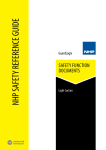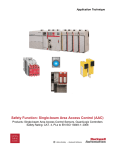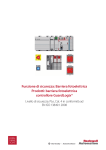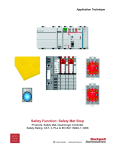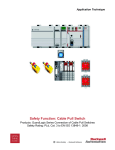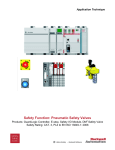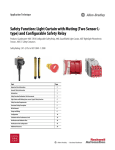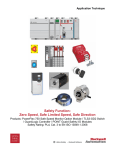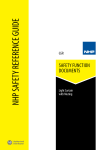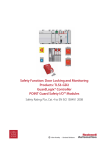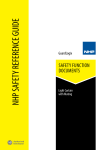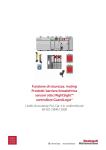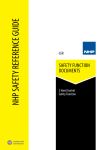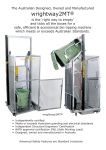Download Safety Function - Rockwell Automation
Transcript
Application Technique Safety Function: SensaGuard Non-contact Interlock Switch Products: SensaGuard Switch, GuardLogix Controller Safety Rating: CAT. 4, PLe to EN ISO 13849-1: 2008 2 Safety Function: SensaGuard Non-contact Interlock Switch Important User Information Read this document and the documents listed in the additional resources section about installation, configuration, and operation of this equipment before you install, configure, operate, or maintain this product. Users are required to familiarize themselves with installation and wiring instructions in addition to requirements of all applicable codes, laws, and standards. Activities including installation, adjustments, putting into service, use, assembly, disassembly, and maintenance are required to be carried out by suitably trained personnel in accordance with applicable code of practice. If this equipment is used in a manner not specified by the manufacturer, the protection provided by the equipment may be impaired. In no event will Rockwell Automation, Inc. be responsible or liable for indirect or consequential damages resulting from the use or application of this equipment. The examples and diagrams in this manual are included solely for illustrative purposes. Because of the many variables and requirements associated with any particular installation, Rockwell Automation, Inc. cannot assume responsibility or liability for actual use based on the examples and diagrams. No patent liability is assumed by Rockwell Automation, Inc. with respect to use of information, circuits, equipment, or software described in this manual. Reproduction of the contents of this manual, in whole or in part, without written permission of Rockwell Automation, Inc., is prohibited. Throughout this manual, when necessary, we use notes to make you aware of safety considerations. WARNING: Identifies information about practices or circumstances that can cause an explosion in a hazardous environment, which may lead to personal injury or death, property damage, or economic loss. ATTENTION: Identifies information about practices or circumstances that can lead to personal injury or death, property damage, or economic loss. Attentions help you identify a hazard, avoid a hazard, and recognize the consequence. IMPORTANT Identifies information that is critical for successful application and understanding of the product. Labels may also be on or inside the equipment to provide specific precautions. SHOCK HAZARD: Labels may be on or inside the equipment, for example, a drive or motor, to alert people that dangerous voltage may be present. BURN HAZARD: Labels may be on or inside the equipment, for example, a drive or motor, to alert people that surfaces may reach dangerous temperatures. ARC FLASH HAZARD: Labels may be on or inside the equipment, for example, a motor control center, to alert people to potential Arc Flash. Arc Flash will cause severe injury or death. Wear proper Personal Protective Equipment (PPE). Follow ALL Regulatory requirements for safe work practices and for Personal Protective Equipment (PPE). Rockwell Automation Publication SAFETY-AT108A-EN-P – December 2013 Safety Function: SensaGuard Non-contact Interlock Switch 3 General Safety Information Contact Rockwell Automation to find out more about our safety risk assessment services. IMPORTANT This application example is for advanced users and assumes that you are trained and experienced in safety system requirements. ATTENTION: Perform a risk assessment to make sure all task and hazard combinations have been identified and addressed. The risk assessment can require additional circuitry to reduce the risk to a tolerable level. Safety circuits must take into consideration safety distance calculations, which are not part of the scope of this document. Table of Contents Important User Information ....................................................................................... 2 General Safety Information ....................................................................................... 3 Introduction ............................................................................................................... 3 Safety Function Realization: Risk Assessment ......................................................... 4 SensaGuard Switch Safety Function ......................................................................... 4 Safety Function Requirements .................................................................................. 4 Functional Safety Description ................................................................................... 5 Bill of Material ........................................................................................................... 5 Setup and Wiring ...................................................................................................... 6 Configuration .......................................................................................................... 10 Programming .......................................................................................................... 17 Calculation of the Performance Level...................................................................... 20 Verification and Validation Plan............................................................................... 24 Additional Resources .............................................................................................. 29 Introduction This safety function application technique explains how to wire, configure, and program a Compact GuardLogix® controller and POINT Guard I/O™ module to monitor both an E-stop button and a SensaGuard™ switch. When the moveable door is opened, the E-stop button is actuated, or a fault is detected in the monitoring circuit, the safety controller de-energizes the final control devices, in this case, a redundant pair of 100S contactors. This example uses a Compact GuardLogix controller, but is applicable to any GuardLogix controller. This example uses a SensaGuard switch and an E-stop button. The SISTEMA software PL calculation tool calculations shown later in this document must be re-calculated if different products are used. Rockwell Automation Publication SAFETY-AT108A-EN-P – December 2013 4 Safety Function: SensaGuard Non-contact Interlock Switch Safety Function Realization: Risk Assessment The required performance level (PLr) is the result of a risk assessment and refers to the amount of the risk reduction to be carried out by the safety-related parts of the control system. Part of the risk reduction process is to determine the safety functions of the machine. In this application, the PLr by the risk assessment is Category 3, Performance Level d (CAT. 3, PLd), for each safety function. A safety system that achieves CAT. 3, PLd, or higher, can be considered control reliable. Each safety product has its own rating and can be combined to create a safety function that meets or exceeds the PLr. From: Risk Assessment (ISO 12100) 1. Identification of safety functions 2. Specification of characteristics of each function 3. Determination of required PL (PLr) for each safety function To: Realization and PL Evaluation SensaGuard Switch Safety Function The safety system described in this application has two safety functions. • Safety-related stop function initiated by the SensaGuard switch • Emergency stop initiated by actuation of an E-stop button This system executes a Stop Category 0 stop. Power is removed and motion coasts to a stop. Safety Function Requirements When the moveable door is opened for access, the SensaGuard switch sends signals to the safety controller to de-energize outputs, stopping the hazardous motion by removing power to the motor. The system cannot be reset while the moveable door is open. Once the door is closed, and the Reset button is pressed and released (a separate action), the electrical circuit is re-established and the machine is ready to start. Pressing the E-stop button stops the hazardous motion by removing power to the motor by the use of two safety contactors. Releasing the E-stop button does not restart the hazardous motion. Pressing and releasing the Reset button after the E-stop button has been reset and all faults are cleared, prepares the machine for Rockwell Automation Publication SAFETY-AT108A-EN-P – December 2013 Safety Function: SensaGuard Non-contact Interlock Switch 5 normal operation (ready to run). The machine runs after the Start button is pressed. A fault at the SensaGuard switch, E-stop, wiring terminals, or safety controller is detected before the next safety demand. The safety system described in this application technique is capable of connecting and interrupting power to motors rated up to 9 A, 600V AC. The safety functions in this application technique each meet or exceed the requirements for Category 3, Performance Level d (CAT. 3, PLd), per EN ISO 13849-1 and control reliable operation per ANSI B11.19. Functional Safety Description The SensaGuard switch and the E-stop button are wired to pairs of safety inputs of a safety input module (SI1). The safety contactors (K1 and K2) are connected to a pair of safety outputs of a safety output module (SO1). The I/O module is connected, via CIP Safety, over an EtherNet/IP network to the safety controller (SC1). The safety code in SC1 monitors the status of the SensaGuard switch and E-stop button by using the pre-certified safety instruction Dual Channel Input Stop (DCS). When all safety input interlocks are satisfied, no faults are detected, and the Reset button is pressed and released, a second pre-certified function block called Configurable Redundant Output (CROUT) controls and monitors feedback for a pair of 100S redundant contactors. Bill of Material This application uses these products. Cat. No. 440N-Z21SS2HN Description 1 SensaGuard, plastic rectangular, 2 x PNP, 0.2 A, max., safety output, 6 in. pigtail, 8-pin micro (M12), margin indication 889D-F8AB-2 DC micro (M12), female, straight, 8-pin, PVC cable, yellow, unshielded, 24AWG, 2 m 800FM-G611MX10 800F push button - metal, guarded, blue, R, metal latch mount, 1 N.O. contact, standard 800FP-MT44PX02S 800F non-illuminated mushroom operators, twist-to-release, 40 mm, round, plastic, red, plastic latch mount, 0 N.O. contacts, 2 N.C. contacts, self-monitoring 800F-1YP3 800F 1-hole enclosure E-stop station, plastic, PG twist-to-release 40 mm, non-illuminated, 2 N.C. contacts 100S-C09EJ23C Bulletin 100S-C - safety contactors, 9 A, 24V DC 1768-ENBT CompactLogix™ EtherNet/IP bridge module 1768-L43S Compact GuardLogix processor, 2.0 Mb standard memory, 0.5 Mb safety memory 1768-PA3 Power supply, 120/240V AC input, 3.5 A@ 24V DC 1769-ECR Right end cap/terminator 1734-AENT 24V DC Ethernet adapter 1734-TB Module base with removable IEC screw terminals 1734-IB8S POINT Guard I/O safety input module 1734-OB8S POINT Guard I/O safety output module 1783-US05T Stratix 2000™ unmanaged Ethernet switch 1 Any 440N-Z SensaGuard product can be used in this application. Rockwell Automation Publication SAFETY-AT108A-EN-P – December 2013 Quantity 1 1 1 1 1 2 1 1 1 1 1 4 1 1 1 6 Safety Function: SensaGuard Non-contact Interlock Switch Setup and Wiring For detailed information on installing and wiring, refer to the product manuals listed in the Additional Resources. System Overview The 1734-IB8S input module monitors two output signal switching devices (OSSD) from the SensaGuard switch. If the moveable door is opened, the SensaGuard switch turns off its two PNP outputs (OSSD Safety A and OSSD Safety B) and the safety controller reacts by turning off the two safety outputs. This removes 24V DC from the coils of the two safety contactors whose contacts open, removing power to the motor. The motor coasts to a stop (Stop Category 0). The SensaGuard switch OSSD outputs (Safety A and Safety B) turn on once the door is closed. The SensaGuard switch monitors its internal circuitry and its OSSD outputs for faults. When a fault in the internal circuitry or an output is detected, the SensaGuard switch responds by turning off its OSSD outputs. The pulse-test outputs (T0 and T1) wired to the 1734-IB8S input module are run through the two N.C. contacts of the E-stop to inputs I2 and I3, respectively. When the E-stop is pressed and released, these circuits are interrupted. The safety controller reacts by turning the safety contacts off. This removes power from the 100S contactor coils and removing 24V DC from the coils of the two 100S contactors, whose contacts open, removing power to the motor. The motor coasts to a stop (Stop Category 0). Shorts to 0V DC (and wire off) are seen as an open circuit by the 1734-IB8S input module and the safety controller reacts by dropping out the safety contactors. If the inputs remain discrepant for longer than the discrepancy time, then the function block Dual Channel Input Stop (DCS) in the safety controller declares a fault. Only after the fault is cleared and the SensaGuard switch or E-stop inputs are cycled (door opened, then closed or push and release the button), is the function block reset. The final control devices are a pair of 100S safety contactors, K1 and K2.The contactors are controlled by a 1734-OB8S safety output module. The contactors are wired in a redundant series configuration. A feedback circuit is wired through the N.C. contacts and back to an input on the 1734-IB8S, to monitor the contactors for proper operation. The contactors cannot restart if the feedback circuit is not in the correct state. The system has individual Reset buttons for resetting faults and safety outputs. The Reset buttons and the two contactor feedbacks circuit are all wired to the 1734-IB8S module in this example. This is not required for functional safety. These three inputs can be wired to a standard input module. Rockwell Automation Publication SAFETY-AT108A-EN-P – December 2013 Safety Function: SensaGuard Non-contact Interlock Switch 7 Installation Refer to the installation instruction and user manuals for guidance on installing and maintaining the different parts of this system. The size of the openings must prevent the operator from reaching the hazard. Table O-10 in U.S. OHSA 1910.217 (f) (4), EN ISO 13854, Table D-1 of ANSI B11.19, Table 3 in CSA Z432, and AS4024.1, provide guidance on the appropriate distance a specific opening must be from the hazard. Hazard Area Stop Switch Actuator Sliding Guard Guard Open – Machine Stopped – Guard Covering Switch RFID Non-Contact Interlock Switches Non-contact interlock switches based on Radio Frequency Identification (RFID) technology can provide a very high level of security against defeat by simple tools. This technology can also be used to provide devices with unique coding for applications where security is paramount. The use of RFID technology has many other important advantages. RFID technology is suitable for use with high-integrity circuit architectures, such as Category 4, Performance Level e, or SIL 3. RFID technology can be incorporated into devices with fully-sealed IP69K enclosures manufactured from plastic or stainless steel. When RFID technology is used for coding, and inductive technology for sensing, a large sensing range and tolerance to misalignment can be achieved, typically 15…25 mm. This means that these devices can provide very stable and reliable service combined with high levels of integrity and security over a wide range of industrial safety applications. The SensaGuard switch interlocks use RFID technology. Rockwell Automation Publication SAFETY-AT108A-EN-P – December 2013 8 Safety Function: SensaGuard Non-contact Interlock Switch Electrical Schematic SensaGuard* Pink Gray K1 K2 Blue White Aux. Contact Fault Reset Safety Reset Yellow Red Brown 24V DC M 1734-IB8S 24V DC COMMON * Stainless steel models have an additional green wire that should be terminated to the power supply ground. E-stop K1 K2 1734-OB8S Rockwell Automation Publication SAFETY-AT108A-EN-P – December 2013 Safety Function: SensaGuard Non-contact Interlock Switch 9 Typical Wiring Diagrams Description Plastic Stainless Steel 3-Shield 8-Safety A+ 4-Safety B+ 8-pin Micro (M12) 8-Safety A+ 4-Safety B+ 7-Ground 6-Safety B 5-Safety A 7-Ground 6-Safety B 5-Safety A 8-pin Cordset 1 889D-F8ABor cable version Gray Safety A Safety A Red Safety A+ Safety A+ Pink Safety B Safety B Yellow Safety B+ Safety B+ White Aux A Aux A Brown 24V DC+ 24V DC+ Blue Gnd Gnd 2 Green NA Shield 1 Replace symbol with 2 (2 m), 5 (5 m), or 10 (10 m) for standard cable lengths. 2 Green wire only applies to the stainless steel model. 24V DC Power Supply Actuator 1 1606 -XL120D Switch 1 Actuator 4 Actuator 5 Switch 2 Switch 3 Switch 4 Switch 5 Pink Actuator 4 is in sensing range Switch 4 is functioning properly Series inputs are 0V DC OSSDs are de-energized to 0V DC Green status indicator is flashing to indicate series inputs are not 24V DC Gray Brown Red Yellow Pink Gray Brown Actuator 3 is in sensing range Switch 3 has fault See table below – Red status indicator is flashing Red Yellow Gray Pink Actuator 2 is in sensing range Switch 2 is functioning properly OSSDs are energized to 24V DC Green status indicator is ON Brown Red Yellow Pink Gray Brown Actuator 1 is in sensing range Switch 1 is functioning properly OSSDs are energized to 24V DC Green status indicator is ON Actuator 3 Red Yellow Pink Gray Brown Red White Yellow Recoverable Fault Actuator 2 Actuator 5 is in sensing range. Switch 5 is functioning properly Series inputs are 0V DC OSSDs are de-energized to 0V DC Green status indicator is flashing to indicate series inputs are not 24V DC 18 mm Actuator Rockwell Automation Publication SAFETY-AT108A-EN-P – December 2013 OSSDs are Off 10 Safety Function: SensaGuard Non-contact Interlock Switch Status Indicators State Device Output Status Indicator Off Red Green Green Flashing Red Flashing Status Not Powered Not Safe, Output Off Safe, Output On Power-up Test 1 Hz Flash Recoverable Fault 4 Hz Flash Nonrecoverable Fault Amber Safe, output on, sensor is Flashing reaching maximum sensing distance Troubleshooting NA NA NA Check 24V DC on safety + outputs (yellow and red wire) Recoverable Fault: Check that safety outputs are not shorted to GND, 24V DC, or each other. Cycle power. Readjust the distance between the actuator and the sensor until output status is green. Configuration Configure the Controller and Add I/O Modules The Compact GuardLogix controller is configured by using RSLogix™ 5000 software, version 17 or later. You must create a new project and add the I/O modules. Then, configure the I/O modules for the correct input and output types. A detailed description of each step is beyond the scope of this document. Knowledge of the RSLogix programming environment is assumed. 1. In RSLogix 5000 software, create a new project. 2. Choose a controller. a. From the Type pull-down menu, choose 1768-L43S CompactLogix 5343S Safety Controller. b. From the Revision pull-down menu, choose the appropriate revision for the controller. c. In the Name box, type an appropriate name for the controller. d. Click OK. Rockwell Automation Publication SAFETY-AT108A-EN-P – December 2013 Safety Function: SensaGuard Non-contact Interlock Switch 11 3. In the Controller Organizer, right-click 1768 Bus and choose New Module. 4. Choose the 1768-ENBT module and click OK. 5. Name the module, type its IP address, and click OK. For this application example, we used 192.168.1.8; however, your IP address can be different. Rockwell Automation Publication SAFETY-AT108A-EN-P – December 2013 12 Safety Function: SensaGuard Non-contact Interlock Switch 6. In the Controller Organizer, right-click the Ethernet network and choose New Module. 7. Select the 1734-AENT adapter and click OK. Rockwell Automation Publication SAFETY-AT108A-EN-P – December 2013 Safety Function: SensaGuard Non-contact Interlock Switch 8. Name the module, type its IP address and click OK. For this application example, we used 192.168.1.11; however, your IP address can be different. 9. Click Change. The Module Definition dialog box appears. 10. From the Chassis Size pull-down menu, choose 3 and click OK. Chassis size is the number of modules that are inserted in the chassis. The 1734-AENT adapter is considered to be in slot 0, so for one input and one output module, the chassis size is 3. Rockwell Automation Publication SAFETY-AT108A-EN-P – December 2013 13 14 Safety Function: SensaGuard Non-contact Interlock Switch The confirmation screen will be displayed. Click Yes to accept the changes. 11. In the Controller Organizer, right-click the PointIO 3 Slot Chassis and choose New Module. 12. Expand Safety, select 1734-IB8S module and click OK. Rockwell Automation Publication SAFETY-AT108A-EN-P – December 2013 Safety Function: SensaGuard Non-contact Interlock Switch 15 13. In the New Module dialog box, name the device IB8S, then click Change. The Module Definition dialog box appears. 14. From the Output Data pull-down menu, choose None. 15. Verify the Input Status is set to Combined Status-Power and click OK. Setting the output data to None means you cannot use the Test Outputs as standard outputs. This saves one controller connection because we are using only the input connection. 16. Repeat steps 11…15 to add the 1734-OB8S safety output module with these exceptions, name the module OB8S, set the module to slot 2, and set the Input Status to Combined Status-Feedback-Power. . Rockwell Automation Publication SAFETY-AT108A-EN-P – December 2013 16 Safety Function: SensaGuard Non-contact Interlock Switch Configure the I/O Modules Follow these steps to configure the POINT Guard I/O modules. 1. In the Controller Organizer, right-click the 1734-IB8S module and choose Properties. 2. Click Test Output and configure the module as shown. 3. Click Input Configuration and configure the module as shown: • Input Points 0/1 are the SensaGuard. • Input Points 2/3 are E-stop buttons. • Input Points 4/5 are the Reset buttons. • Input Point 7 is the contactor monitoring circuit. Inputs Point 2 and 3 are being sourced from Test Output 0 and 1, respectively. Input Point 7 is being sourced from Test Output 2. 4. Click OK. 5. In the Controller Organizer, right-click the 1734-OB8S module and choose Properties. Rockwell Automation Publication SAFETY-AT108A-EN-P – December 2013 Safety Function: SensaGuard Non-contact Interlock Switch 17 6. Click Output Configuration and configure the module as shown. Typically, contactor coils will not react to the pulse testing of the output wires. If using a contactor that does react to the pulse test, then disable the pulse testing. This should not affect the overall safety rating if redundancy and monitoring are being utilized. 7. Click OK. Programming The Dual Channel Input Stop (DCS) instruction monitors dual-input safety devices whose main function is to stop a machine safely, for example, an E-stop, light curtain, or safety gate. In this example, the DCS instruction is being used to monitor a SensaGuard switch and an E-stop button. The DCS instruction monitors dual-input channels for consistency (Equivalent-Active High) and detects and traps faults when the inconsistency is detected for longer than the configured Discrepancy Time (ms). The automatic restart type allows the DCS output (O1) to reset automatically after a demand. The manual action typically required for safety is provided in rung 1 to reset the safety output enable. Input Status typically represents the channel status of the two input channels. In this example, the Combined Input Status bit goes low (0) if any of the eight input channels has a fault. In this example, the DCS reset acts as a fault reset. Even when configured for automatic restart, a reset is required to recover from a fault. The output (01) of the DCS instruction is used as a safety interlock in the seal-in rung to drive the output enable tag. If the DCS output drops out, so does the output enable, and it remains off until you manually reset it. The Configurable Redundant Output (CROUT) instruction controls and monitors redundant outputs. Essentially, this instruction verifies that feedback follows the safety outputs appropriately. For the negative feedback used in this example, if the outputs are high (1), the Feedback is low (0) and vice versa. In this example, the feedback has 500 ms to change to the proper state. Because only a single feedback circuit is being used, the feedback tag is used for both Feedback 1 and 2. Rockwell Automation Publication SAFETY-AT108A-EN-P – December 2013 18 Safety Function: SensaGuard Non-contact Interlock Switch The two output tags from the CROUT instruction are used to drive the contactor outputs on the 1734-OB8S module. Rockwell Automation Publication SAFETY-AT108A-EN-P – December 2013 Safety Function: SensaGuard Non-contact Interlock Switch 19 Falling Edge Reset EN ISO 13849-1 stipulates that instruction reset functions must occur on falling edge signals. To comply with this requirement, add a One Shot Falling (OSF) instruction to the rung immediately preceding the Cmd_Zone1_OutputEnable rung, then use the OSF instruction Output Bit tag as the reset bit for the following rung. The Cmd_Zone1_OutputEnable is still used to enable the CROUT instruction. The modified code appears below in rungs 1 and 2. Rockwell Automation Publication SAFETY-AT108A-EN-P – December 2013 20 Safety Function: SensaGuard Non-contact Interlock Switch Calculation of the Performance Level The required Performance Level (PLr) from the risk assessment is Category 3, Performance Level d (CAT. 3, PLd). When properly implemented, the safety functions described can achieve CAT. 4, PLe, according to EN ISO 13849-1: 2008, as calculated by using the SISTEMA software PL calculation tool. Calculations are based on each safety function being operated 5 times an hour, 12 hours a day, 365 days a year, for a total of 21,900 operations a year. The 100S contactors are used in both safety functions; therefore, their calculations are based on 43,800 operations per year. The measures against Common Cause Failure (CCF) are quantified by using the scoring process outlined in Annex F of EN ISO 13849-1. For the purposes of the PL calculation, the required score of 65 needed to fulfill the CCF requirement is considered to be met. The complete CCF scoring process must be performed when implementing this example. The subsystem values are shown below. The overall safety project Performance Level is shown below. This safety System includes two safety functions, a SensaGuard safety function and an E-stop safety function. The two safety functions can be represented in block diagrams. Rockwell Automation Publication SAFETY-AT108A-EN-P – December 2013 Safety Function: SensaGuard Non-contact Interlock Switch 21 The SensaGuard safety function can be modeled as shown in the following safety-related block diagram. K1 100S SensaGuard 1734-IB8S 1768-L43S 1734-OB8S K2 100S Subsystem 1 Subsystem 2 Subsystem 3 Subsystem 4 Subsystem 5 Subsystems: SensaGuard, Safety I/O, Compact GuardLogix, and safety contactors modeled as shown below. SensaGuard Safety Function Subsystem 1 SensaGuard Safety Function Subsystem 2 Rockwell Automation Publication SAFETY-AT108A-EN-P – December 2013 22 Safety Function: SensaGuard Non-contact Interlock Switch SensaGuard Safety Function Subsystem 3 SensaGuard Safety Function Subsystem 4 SensaGuard Safety Function Subsystem 5 The E-Stop safety function is represented below. E-stop 1 B1/E1 K1 100S 1734-IB8S 1768-L43S 1734-OB8S Estop 1 B2/E2 K2 100S Subsystem 1 Subsystem 2 Subsystem 3 Subsystem 4 Subsystem 5 Rockwell Automation Publication SAFETY-AT108A-EN-P – December 2013 Safety Function: SensaGuard Non-contact Interlock Switch 23 Subsystems: E-stop, Safety I/O, Compact GuardLogix, and safety contactors modeled as shown below. The E-stop Performance Level is shown below. Because these are electro-mechanical devices, the safety contactors data includes the following: • Mean Time to Failure, dangerous (MTTFd) • Diagnostic Coverage (DCavg) • Common Cause Failure (CCF) Electro-mechanical devices’ functional safety evaluations include the following: • How frequently they are operated • Whether they are effectively monitored for faults • Whether they are properly specified and installed SISTEMA software calculates the MTTFd by using B10d data provided for the contactors along with the estimated frequency of use, entered during the creation of the SISTEMA project. This application example presumes that the E-stop is operated or tested at least once per day, for a total of 365 times a year. The DCavg (99%) for the contactors is selected from the Output Device table of EN ISO 13849-1 Annex E, Direct Monitoring. The DCavg (99%) for the E-Stop is selected from the Input Device table of EN ISO 13849-1 Annex E, Cross Monitoring. Rockwell Automation Publication SAFETY-AT108A-EN-P – December 2013 24 Safety Function: SensaGuard Non-contact Interlock Switch Verification and Validation Plan Verification and validation play important roles in the avoidance of faults throughout the safety system design and development process. EN ISO 13849-2 sets the requirements for verification and validation. The standard calls for a documented plan to confirm all of the safety functional requirements have been met. Verification is an analysis of the resulting safety control system. The Performance Level (PL) of the safety control system is calculated to confirm that the system meets the required Performance Level (PLr) specified. The SISTEMA software is typically used to perform the calculations and assist with satisfying the requirements of EN ISO 13849-1. Validation is a functional test of the safety control system to demonstrate that the system meets the specified requirements of the safety function. The safety control system is tested to confirm that all of the safety-related outputs respond appropriately to their corresponding safety-related inputs. The functional test includes normal operating conditions in addition to potential fault injection of failure modes. A checklist is typically used to document the validation of the safety control system. Validation of software development is the process in which similar methodologies and techniques that are used in hardware development are deployed. Faults created through poor software development processes and procedures are systemic in nature rather than faults associated with hardware, which are considered as random. Prior to validating the GuardLogix Safety System, it is necessary to confirm that the safety system and safety application program have been designed in accordance with the GuardLogix System Safety Reference Manuals, publication 1756-RM093 (GuardLogix 5560 and Compact GuardLogix controllers) and 1756-RM099 (GuardLogix 5570 controllers), and the GuardLogix Application Instruction Safety Reference Manual, publication 1756-RM095. Rockwell Automation Publication SAFETY-AT108A-EN-P – December 2013 Safety Function: SensaGuard Non-contact Interlock Switch 25 GuardLogix/SensaGuard - Safety Function Verification and Validation Checklist General Machinery Information Machine Name/Model Number Machine Serial Number Customer Name Test Date Tester Name(s) Schematic Drawing Number Controller Name Safety Signature 10 Safety Network Number(s) RSLogix 5000 Software Version Safety Control System Modules GuardLogix Safety Controller CompactLogix Ethernet Bridge POINT I/O™ Ethernet Adapter POINT I/O Input Modules POINT I/O Output Modules GuardLogix Modules Firmware Revision 1768-L43S 1768-ENBT 1734-AENT 1734-IB8S 1734-OB8S GuardLogix Safety System Configuration and Wiring Verification Test Step Verification Pass/Fail Changes/Modifications Verify that the safety system has been designed in accordance with the GuardLogix System Safety reference manuals listed in the Additional Resources. Verify that the safety application program has been designed in accordance with the GuardLogix Application reference manuals listed in the Additional Resources. Visually inspect the safety system network and verify that the I/O is wired as documented in the schematics. Visually inspect the SensaGuard switch to verify that it is configured as documented. Visually inspect the RSLogix 5000 program to verify that safety system network and I/O module configuration is configured as documented. Visually inspect the RSLogix 5000 application program to verify that suitable safety-certified instructions are used. The logic is readable, understandable, and testable, with the aid of clear comments. All input devices are qualified by cycling their respective actuators. Monitor the status in the RSLogix 5000 Controller Tags window. All output devices are qualified by cycling their respective actuators. Monitor the status in the RSLogix 5000 Controller Tags window. Rockwell Automation Publication SAFETY-AT108A-EN-P – December 2013 26 Safety Function: SensaGuard Non-contact Interlock Switch GuardLogix/SensaGuard - Safety Function Verification and Validation Checklist (continued) Normal Operation Verification - The GuardLogix safety system properly responds to all normal Start, Stop, E-stop and Reset commands. Test Step Verification Pass/Fail Changes/Modifications Initiate a Start command. Both contactors energize for a normal machine run condition. Verify proper machine status indication and RSLogix 5000 safety-application program indication. Initiate a Stop command. Both contactors de-energize for a normal machine stop condition. Verify proper machine status indication and RSLogix 5000 safety-application program indication. While the system is running, open the moveable door. Both contactors de-energize and open for a normal safe condition. Verify proper machine status indication and RSLogix 5000 safety-application program indication. Repeat for all SensaGuard switches. While the system is stopped and the door is open, initiate a Start command. Both contactors remain de-energized and open for a normal safe condition. Verify proper machine status indication and RSLogix 5000 safety-application program indication. While the system is running, press the E-stop button. Both contactors de-energize and open for a normal safe condition. Verify proper machine status indication and safety relay status indicator indication. Repeat for all E-stop buttons. While the system is stopped, press the E-stop button and initiate a Start command. Both contactors remain de-energized and open for a normal safe condition. Verify proper machine status indication and safety-relay status indicator indication. Repeat for all E-stop buttons. Initiate a Reset command. Both contactors remain de-energized. Verify proper machine status indication and RSLogix 5000 safety-application program indication. Rockwell Automation Publication SAFETY-AT108A-EN-P – December 2013 Safety Function: SensaGuard Non-contact Interlock Switch 27 GuardLogix/SensaGuard - Safety Function Verification and Validation Checklist (continued) Abnormal Operation Validation -The GuardLogix safety system properly responds to all foreseeable faults with corresponding diagnostics. E-stop Input Tests Test Step Validation Pass/Fail Changes/Modifications While the system is running, remove the channel 1 wire from the safety I/O module. Both contactors de-energize. Verify proper machine status indication and RSLogix 5000 safety-application program indication. Verify that the system is unable to reset and restart with a fault. Restore channel 1 and repeat for channel 2. While the system is running, short channel 1 of the safety I/O module to 24V DC. Both contactors de-energize. Verify proper machine status indication and RSLogix 5000 safety-application program indication. Verify that the system is unable to reset and restart with a fault. Restore channel 1 and repeat for channel 2. While the system is running, short channel 1 of the safety I/O module to 0V DC. Both contactors de-energize. Verify proper machine status indication and RSLogix 5000 safety-application program indication. Verify that the system is unable to reset and restart with a fault. Restore channel 1 and repeat for channel 2. While the system is running, short channels 1 and 2 of the safety I/O module. Both contactors de-energize. Verify proper machine status indication an RSLogix 5000 safety-application program indication. Verify that the system is unable to reset and restart with a fault. Restore channel 1 and channel 2 wiring. Rockwell Automation Publication SAFETY-AT108A-EN-P – December 2013 28 Safety Function: SensaGuard Non-contact Interlock Switch GuardLogix/SensaGuard - Safety Function Verification and Validation Checklist (continued) SensaGuard Input Tests Test Step Validation Pass/Fail Changes/Modifications While the system is running, remove the channel 1 wire from the safety I/O module. Both contactors de-energize. Verify proper machine status indication and RSLogix 5000 safety-application program indication. Verify that the system is unable to reset and restart with a fault. Restore channel 1 and repeat for channel 2. While the system is running, short channel 1 of the safety I/O module to 24V DC. Both contactors de-energize. Verify proper machine status indication and RSLogix 5000 safety-application program indication. Verify that the system is unable to reset and restart with a fault. Restore channel 1 and repeat for channel 2. While the system is running, short channel 1 of the safety I/O module to 0V DC. Both contactors de-energize. Verify proper machine status indication and RSLogix 5000 safety-application program indication. Verify that the system is unable to reset and restart with a fault. Restore channel 1 and repeat for channel 2. While the system is running, short channels 1 and 2 of the safety I/O module. Both contactors de-energize. Verify proper machine status indication and RSLogix 5000 safety-application program indication. Verify that the system is unable to reset and restart with a fault. Restore channel 1 and channel 2 wiring. GuardLogix Controller and Network Tests Test Step Verification and Validation Pass/Fail Changes/Modifications While the system is running, remove the Ethernet network connection between the safety I/O module and the controller. All contactors de-energize. Verify proper machine status indication and I/O connection status in the RSLogix 5000 safety-application program. Restore the safety I/O module network connection and allow time to re-establish communication. Verify the state of the connection status bit in the RSLogix 5000 safety-application program. Repeat for all safety I/O connections. While the system is running, switch the controller out of Run mode. All contactors de-energize. Return the keyswitch back to Run mode. All contactors remain de-energized. Verify proper machine status indication and RSLogix 5000 safety-application program indication. Rockwell Automation Publication SAFETY-AT108A-EN-P – December 2013 Safety Function: SensaGuard Non-contact Interlock Switch 29 GuardLogix/SensaGuard - Safety Function Verification and Validation Checklist (continued) Safety Contactor Output Tests Test Step Verification and Validation Pass/Fail Changes/Modifications Initiate a Start command. Both contactors energize for a normal machine run condition. Verify proper machine status indication and RSLogix 5000 safety-application program indication. While the system is running, remove the contactor feedback from the safety I/O module. All contactors remain energized. Initiate a Stop command and attempt a Reset command. The system does not restart or reset. Verify proper machine status indication and RSLogix 5000 safety-application program indication. While the system is running, short the contactor feedback to the safety I/O module. All contactors remain energized. Initiate a Stop command and attempt a Reset command. The system does not restart or reset. Verify proper machine status indication and RSLogix 5000 safety-application program indication. Additional Resources Refer to these publications for more information about related products from Rockwell Automation. Resource Compact GuardLogix Controllers User Manual, publication 1768-UM002 POINT Guard I/O Safety Modules Installation and User Manual, publication 1734-UM013 GuardLogix Control Systems Safety Reference Manual, publication 1756-RM093 GuardLogix Safety Application Instruction Set Reference Manual, publication 1756-RM095 GuardLogix 5570 Controller Systems Safety Reference Manual, publication 1756-RM099 Safety Accelerator Toolkit for GuardLogix Systems Quick Start Guide, publication IASIMP-QS005 SensaGuard Integrated Latch Unique Coded Installation Instructions, publication 10000121840 Ver 03 SensaGuard 18 mm Stainless Steel Barrel Installation Instructions, publication 75056-181-05 Description Provides information on configuring, operating, and maintaining Compact GuardLogix controllers. Provides information on installing, configuring, and operating POINT Guard I/O modules. Provides detailed requirements for achieving and maintaining safety ratings with the GuardLogix and Compact GuardLogix controller systems. Provides detailed information on the GuardLogix Safety Application Instruction Set. Contains detailed requirements for achieving and maintaining safety ratings with the GuardLogix 5570 controller system. Provides a step-by-step guide to using the design, programming, and diagnostic tools in the Safety Accelerator Toolkit. Provides detailed installation instructions for the SensaGuard coded sensor. Provides detailed installation instructions for the SensaGuard coded sensor. Rockwell Automation Publication SAFETY-AT108A-EN-P – December 2013 30 Safety Function: SensaGuard Non-contact Interlock Switch Resource SensaGuard Rectangular Flat Pack Installation Instructions, publication 10000182958 Ver 00 SensaGuard Rectangular Flat Pack Installation Instructions, publication 75056-179 Ver 04 SensaGuard 18 mm Plastic Barrel Installation Instructions, publication 75056-180/3 SensaGuard Rectangular Flat Pack Unique Coded Installation Instructions, publication PN-46047 SensaGuard 18 mm Stainless Steel Barrel Unique Coded Installation Instructions, publication PN-46046 SensaGuard 18 mm Plastic Barrel Unique Coded Installation Instructions, publication PN-46045 Safety Products Catalog, publication S117-CA001 Description Provides detailed installation instructions for the SensaGuard 18 mm stainless steel barrel sensor. Provides detailed installation instructions for the SensaGuard rectangular flat pack sensor. Provides detailed installation instructions for the SensaGuard 18 mm plastic barrel sensor. Provides detailed installation instructions for the SensaGuard rectangular flat pack unique coded sensor. Provides detailed installation instructions for the SensaGuard 18 mm stainless steel barrel unique coded sensor. Provides detailed installation instructions for the SensaGuard 18 mm plastic barrel unique coded sensor. Provides an overview of products, product specifications, and application examples. You can view or download publications at http://www.rockwellautomation.com/literature. To order paper copies of technical documentation, contact your local Allen-Bradley distributor or Rockwell Automation sales representative. For more information on Safety Function Capabilities, visit: discover.rockwellautomation.com/safety Rockwell Automation, Allen-Bradley, Rockwell Software, Compact GuardLogix, POINT Guard I/O, POINT I/O, SensaGuard, CompactLogix, Stratix 2000, RSLogix, and LISTEN.THINK.SOLVE. are trademarks of Rockwell Automation, Inc. Trademarks not belonging to Rockwell Automation are property of their respective companies. Publication SAFETY-AT108A-EN-P – December 2013 Copyright © 2013 Rockwell Automation, Inc. All rights reserved. Printed in U.S.A.






























